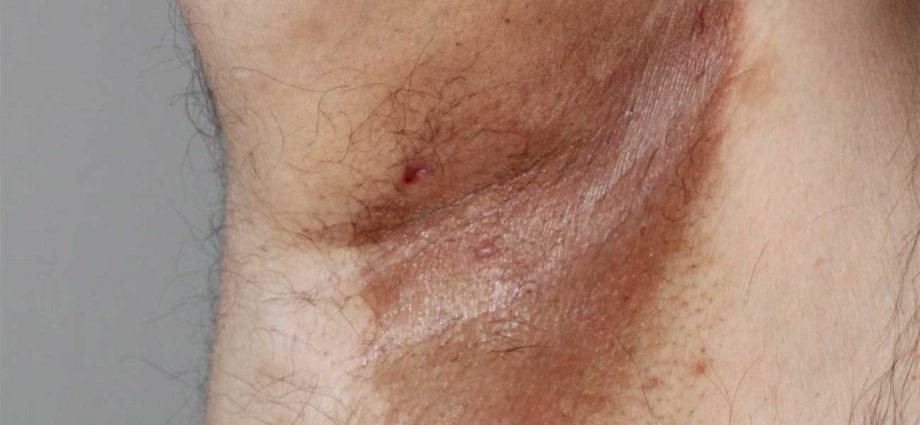Contents
General description of the disease
This is an infection of the skin of a chronic and bacterial nature, spreading only to the upper layer of the skin, and in no way affecting the hair and the nail plate.
Transfer method – through the use of someone else’s clothing and household items of a sick person.
Signs of erythrasma
The disease has a slow and almost imperceptible course. An infected person may not notice the problem for a long time. The first symptom is the appearance of spots on the skin, which can be red, brown, yellow or pink. Their size varies from small dots to several centimeters, spots can merge into one large one. Infected areas may experience itching, tingling, pain and burning sensations.
To diagnose the disease, a special Wood lamp is used, the rays of which will show the affected areas of the skin in a red-coral shade (before the procedure, sore spots cannot be treated with anything).
The reasons for the appearance of erythrasma:
- increased sweating;
- regular injury to the skin;
- altered skin pH (towards alkali);
- warm, humid climate or room;
- maceration;
- sexual intercourse with carriers of this infection or with patients with erythrasma;
- stay on the beach, sauna, swimming pool;
- obesity, diabetes mellitus and other problems and disruptions in the endocrine system;
- violation of personal hygiene rules;
- retirement age.
Locations: in males – inguinal, femoral, axillary regions; in women – the area around the navel, armpits, folds on the abdomen, under the breast; between the toes and any other folds of skin that are present (applies to both).
Useful foods for erythrasma
- 1 vegetable origin: greens, vegetable salads (green vegetables are especially useful – peppers, zucchini, squash, cucumbers, cabbage of all kinds), nuts (almonds, peanuts, cashews), cereals (oatmeal, wheat, yach, buckwheat), cereals, dried fruits, seeds, citrus fruits, seaweed;
- 2 animal origin: sour milk products, boiled chicken eggs, sea fish, offal (boiled kidneys, lungs, liver, bronchi, tongue), honey;
- 3 beverages: green tea, non-carbonated mineral waters, compotes, juices.
Since mainly obese people suffer from erythrasma, they must follow a diet – carbohydrate food must be eaten in the morning, and proteins – in the evening. All dishes must be steamed, stewed or boiled. Drink the required amount of water (at least 2 liters). Choose products of good quality, fresh, not sealed in polyethylene. Also, you need to evenly distribute calories, meals should be at least 4-5, the last one – at least 2 hours before bedtime.
Traditional medicine for erythrasma
In order to defeat erythrasma and in the future to avoid a recurrence of the problem, it is necessary to adhere to the following basic principles:
- take a bath and change linen several times a day (especially with heavy weight and in extreme heat);
- do not wear synthetic clothing and underwear;
- do not take other people’s towels, linen and other personal hygiene products;
- smear the lesions with erythromycin ointment (twice a day after bathing, for a decade);
- to speed up the treatment, take baths with decoctions of herbs from birch buds, bog rosemary shoots;
- make lotions and compresses from tinctures of chamomile, calamus root, walnut leaves, celandine, calendula, lubricate sore spots with propolis oil;
- drink decoctions of medicinal herbs with tonic properties: chamomile, nettle, linden, thyme, wild rose, hawthorn, string;
- to reduce sweating, you need to take a bath with the addition of baking soda, slaked vinegar 6 percent.
If, after 14 days, the result of the treatment is not visible, you need to seek help from a doctor.
Dangerous and harmful foods with erythrasma
- drinks: sweet soda, alcohol (beer, champagne, fizzy and sparkling wines), kvass;
- any baked goods made from yeast dough;
- mushrooms;
- pickled, smoked products;
- seasonings and sauces: vinegar, ketchup, mayonnaise, soy sauce, various marinades (especially store-bought);
- any sweets and sugar;
- fermented milk products with fillers;
- spicy cheeses, blue cheeses;
- canned food, sausages and sausages;
- instant food, chips, crackers, fast food, food with preservatives and all kinds of additives (dyes, fillers, E, sour and sorbitol);
- fermented fruits and vegetables;
- food that was stored in the refrigerator in a cut form in plastic containers, plastic bags for more than a day.
These products create a favorable environment for the growth of bacteria, slag the body, which causes problems with metabolic processes in the body (can lead to a greater degree of obesity and the appearance of new skin folds, in which new red spots appear).
Also, if you are allergic to any foods or drugs, exclude their consumption.
Attention!
The administration is not responsible for any attempt to use the information provided, and does not guarantee that it will not harm you personally. The materials cannot be used to prescribe treatment and make a diagnosis. Always consult your specialist doctor!










